 Can you guess which types of tuna are on this plate?
Can you guess which types of tuna are on this plate?I’ll tell you in a minute, but first let’s talk about tuna’s success story.
In the matter of a decade, this Rockefeller of fish, rose from rags to riches (or cans to sushi as we say in the fish world), drawing the looks of contempt, admiration, and envy from other fish. While salmon became the middle class of a fish – affordable, reliably available in any supermarket, and the token fish on restaurant menus – tuna has been making it big. It has grades, it has types, and it has that sexy rare center daring you to eat raw fish outside of a sushi restaurant.
“It’s sushi grade, right?” we ask our waiter as if to make sure it was blessed by the local sushi board similar to a rabbi declaring meat to be kosher. “Absolutely,” he replies nodding his head so confidently, you’d think he saw the sushi board stop by just a few hours ago to inspect the fish.
I still remember the first time I ordered a tuna steak, and the waitress asked me how I wanted it cooked. No restaurant has ever asked me to make that important decision about fish before and I was at a loss. After a few moments of hard thinking, I chickened out and ordered it medium-well. I felt as if one of my college friends offered me a joint and I turned it down trying to be the good kid. I'd eaten raw fish for years in sushi restaurants, but that was a totally different story. That was like drugs with prescription from a doctor. Raw fish in a regular restaurant, or God forbid in my house, seemed every bit as scary and illegal as recreational drugs.
Curiosity, of course, won over the fear of “unsupervised” raw tuna and I’ve been happily consuming it for the past 5 years with no adverse side effects besides temporary euphoria and random bursts of giggles. But besides gobbling up tuna tartare, sashimi, and steaks, I’ve also been reading a lot about this fascinating fish and bothering fishmongers with my never-ending questions.
Have you ever wondered what sushi grade really means? And what about all those other words like bluefin, yellowfin, big-eye, ahi, Number 1, Grade 1, etc. When I have a question that all my fish books fail to answer, I pick up the phone and call Carl Fantasia at the New Deal Fish Market. It’s amazing how much light a 10 minute conversation with Carl can shed on pretty much any seafood topic. Here is what I learned about tuna:
When it comes to top tier tuna (the steak kind you pay big bucks for vs. the stuff in a can), there are 3 species you are most likely to see in fish markets and restaurants:
- Yellowfin (also sold as Ahi)
- Big-eye
- Bluefin
Big-eye is much fattier and more flavorful than yellowfin. It retails for low $20s/Lb and at its prime can rival bluefin.
Bluefin is the Rolls-Royce of all tuna, prized for its bright red color, fattiness, and flavor. At its prime (the end of summer and early fall) when it swims north and fattens up, it can retail for close to $30/Lb. Not even the sushi restaurants can market this tuna effectively to the US consumers, and 99% of this lovely bluefin that we catch in the North Atlantic waters gets whisked off to Japan.
Correction about Ahi posted on August 7, 2006: I have written incorrectly in the original version of this post that Ahi is another name for Big-eye. That's what happens when you use Internet sources -- they aren't always right (except for Beyond Salmon of course ;) Thanks to Carl for finding this mistake. Ahi is a marketing term used for Yellowfin, not Big-eye tuna.
Of course, how good your tuna tastes depends not only on the species, but also on the season and even on each particular fish. That’s where the “grade” comes into the picture. When each tuna is caught, it gets pierced with a long probe and evaluated for color and fat content. The greasier the probe comes back, the higher the grade. Of course, it’s not a very scientific process, and what one distributor calls #1, the other might call 2+. The grades range from 1 (the best) to 3 (the worst). #1, 2+, and 2 all taste good enough to eat raw and can be sold for use in rare steaks, and sushi. This has nothing to do with the freshness of the fish, only with its taste. Since “#2+ Grade Tuna” sounds like they are serving you second grade fish, the restaurant menus will never use that terminology. They’ll either say “#1 Tuna”, or use the species name to describe it, like “Ahi Tuna.” Of course all these words don’t mean much, and you don’t really know how good that tuna is until you taste it. If this wasn’t complicated enough already, another variable in this tuna equation is the cut. The mid-section near the belly is the fattiest and most expensive, and the tail is the cheapest.
But what about the sushi grade? “Sushi grade” or “sushi quality” simply means the fish is fresh and has been properly kept on ice. A good fish market will take such care of all their fish and will be able to advice you on which fish are the freshest and good enough to eat raw. So “sushi grade” is more of a marketing term than a grade really. No authority gives this ephemeral “grade” out. Think about it this way. If you buy sushi carry out at a sushi restaurant, then take it home in a hot car on a summer day, and store it in your 42 degree fridge for a few hours, is that fish still “sushi grade”? So don’t worry about the grade. Worry about freshness. A really fresh tuna is easy to spot since it has no pearly rainbow discolorations, no smell, and no sleazy discharge. Buy it from a reputable fish market. Bring it home in a cooler with ice-packs, store it in the fridge (yes, still between ice-packs), and eat it that day. If you’d like a “sushi grade” certification, just give me a call. I’d be happy to issue one, after a thorough tasting of your tuna.
Keep in mind that the above advice only applies to tuna and a few other salt water fish. Most fresh water fish and some salt water fish are prone to parasites and are not safe to eat raw. So if you go fishing in the river, don’t serve that fish for sushi no matter how fresh it is.
Now that I’ve tortured you long enough, here is the answer to the tuna mystery…
The one on the top that is darker is bluefin ($18/Lb) from Court House Seafood and the one on the bottom that is lighter is big-eye ($22/Lb) from the New Deal Fish Market. How come the Rolls-Royce of tuna is cheaper than the big-eye? Bluefin is on the lean side right now and not at its best, though still better than tuna at most of Boston’s sushi restaurants. The big-eye, on another hand, is just spectacular. You see how pink it is? If you looked really closely, you’d see a spider web of fatty marbling running through its flesh making it melt in the mouth like sweet butter. This is as good as big-eye gets, or at least as good as I’ve ever tasted.

Mmmm -- fatty tuna...
Priceless.
For everything else, there is MasterCard®.

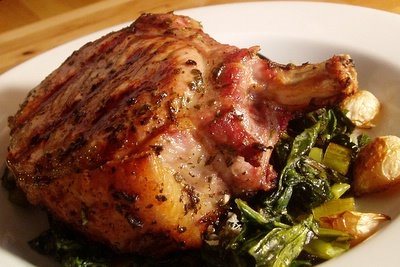
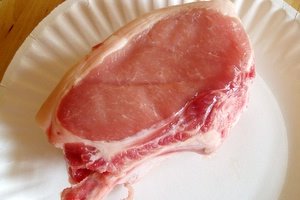

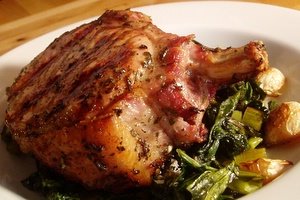
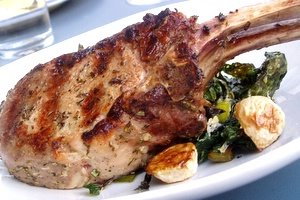

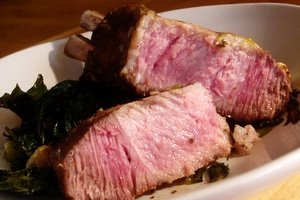
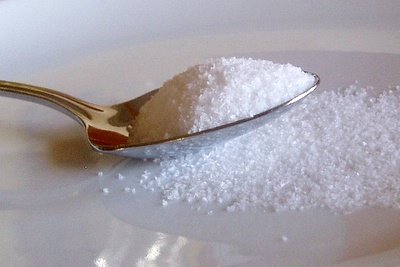 Why do “gourmet” home cooks crave a Big Mac on occasion? Could it be the texture of the overcooked meat squashed with the spatula until all the juices run out? Or aroma of the processed buns and styrofoam tomatoes? What could be missing from our organic, from-scratch home cooking that is found in the pit of despair known as McDonald’s?
Why do “gourmet” home cooks crave a Big Mac on occasion? Could it be the texture of the overcooked meat squashed with the spatula until all the juices run out? Or aroma of the processed buns and styrofoam tomatoes? What could be missing from our organic, from-scratch home cooking that is found in the pit of despair known as McDonald’s?
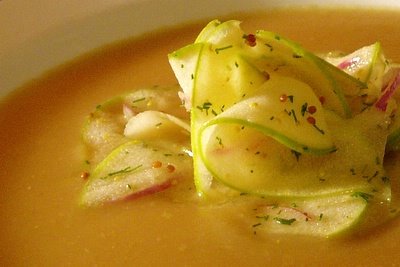 My first encounter with innovative cuisine happened at the ripe age of 7. If you were picturing a little girl tasting asparagus mousse with black caviar in a 3 star restaurant, you’ll have to scrap that image and replace it with that of a little girl with sandy feet, and a man with a dark beard and kind brown eyes sitting at a picnic table under an apricot tree with two bowls of soup in front of them. The little girl was me. The man with a beard was my Dad. The soup was supposed to be a cream of vegetables, but looked suspiciously like a cream of something brown and icky. The place was Novopetrovka, a small village on the coast of Azov Sea in Ukraine. Not only were there no restaurants in Novopetrovka, there were no cafes, cafeterias, or even fast food joints. American fathers don’t know how easy they have it. If they are stuck with a hungry 7 year old, they can always count on McDonald’s to save their ass, while Russian fathers can only count on their ingenuity.
My first encounter with innovative cuisine happened at the ripe age of 7. If you were picturing a little girl tasting asparagus mousse with black caviar in a 3 star restaurant, you’ll have to scrap that image and replace it with that of a little girl with sandy feet, and a man with a dark beard and kind brown eyes sitting at a picnic table under an apricot tree with two bowls of soup in front of them. The little girl was me. The man with a beard was my Dad. The soup was supposed to be a cream of vegetables, but looked suspiciously like a cream of something brown and icky. The place was Novopetrovka, a small village on the coast of Azov Sea in Ukraine. Not only were there no restaurants in Novopetrovka, there were no cafes, cafeterias, or even fast food joints. American fathers don’t know how easy they have it. If they are stuck with a hungry 7 year old, they can always count on McDonald’s to save their ass, while Russian fathers can only count on their ingenuity.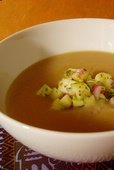



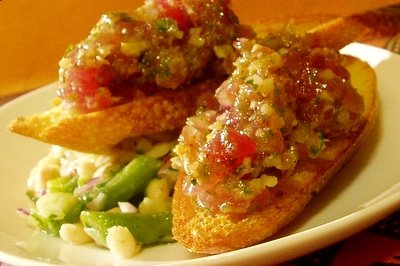 You might be wondering if I've been cooking anything interesting lately, or just writing about the
You might be wondering if I've been cooking anything interesting lately, or just writing about the 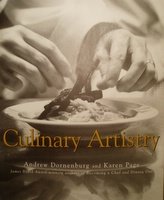 A flight from Boston to San-Francisco needs a good book – Angels and Demons or Harry Potter type page turner to numb my mind with cliff hanging excitement and help me get through 6 hours of sitting. But this time, I didn’t plan far enough in advance and wasn’t prepared with the properly addictive novel. Desperate to grab something that had a cover and enough pages to keep me occupied, I stuffed
A flight from Boston to San-Francisco needs a good book – Angels and Demons or Harry Potter type page turner to numb my mind with cliff hanging excitement and help me get through 6 hours of sitting. But this time, I didn’t plan far enough in advance and wasn’t prepared with the properly addictive novel. Desperate to grab something that had a cover and enough pages to keep me occupied, I stuffed 







